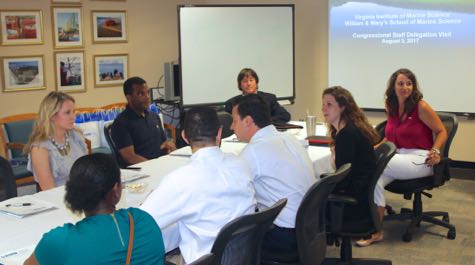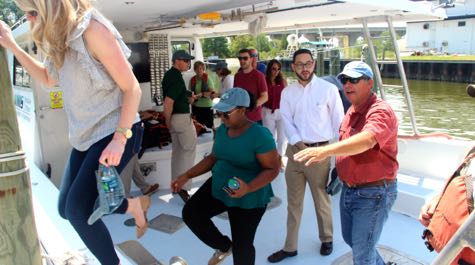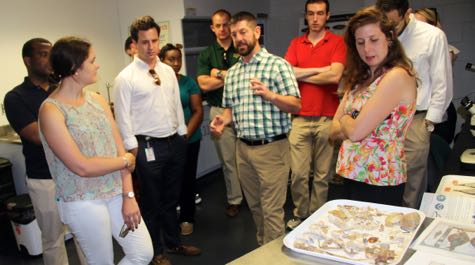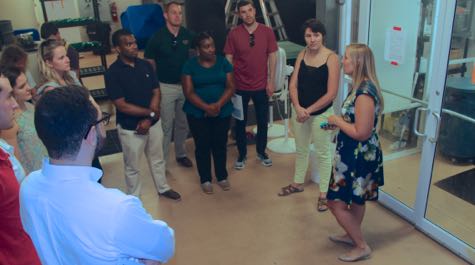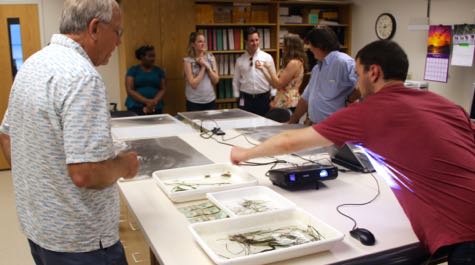Virginia congressional staffers visit VIMS
Use summer recess to learn about Chesapeake Bay and coastal issues
As the U.S. House and Senate break for their traditional summer recess, a group of congressional staffers used the opportunity for a visit to the Virginia Institute of Marine Science to learn how its faculty, staff, and students are working to address the issues facing Chesapeake Bay and the coastal ocean.
Making the trip were Donald Pollard from the Office of Senator Tim Kaine; Kate Schisler from the Office of Congressman Don Beyer; Ryan McManus (Congresswoman Barbara Comstock); Evan Chapman, L’Allegro Smith, and Taylor Williamson (Congressman Bobby Scott); Laura Lyon (Congressman Scott Taylor); and Kathleen Gayle and Austin Walton (Congressman Rob Wittman). Arranging the visit was Colin Smolinsky, Assistant Director of Government Relations at William & Mary.
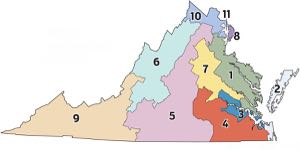
The staffers—legislative assistants and aides with portfolios focused on the environment, natural resources, and higher education—are responsible for helping their elected official stay informed concerning these issues and how they affect Virginia and the nation.
The group began their visit with an overview of VIMS and its mission from Dr. Mark Luckenbach, Associate Dean of Research and Advisory Services; and Jennifer Latour, Chief Financial & Administrative Officer. The discussion touched on the significant role federal funding plays in VIMS’ work and how the fiscal landscape may evolve as the legislative cycle moves forward this fall. The staffers also received an update on W&M’s AidData program from Siddhartha “Sid” Ghose, a data specialist in AidData’s Policy Analysis Unit.
The congressional staffers continued their visit with a boat trip to the Goodwin Islands—one of four York River reserve sites owned and managed by the Chesapeake Bay National Estuarine Research Reserve program at VIMS—where Dr. William Reay, CBNERR director, gave them a first-hand look at the islands’ pristine environment and vital role in research and education.
After returning to Gloucester Point, the staffers enjoyed a visit to the VIMS Oyster Hatchery. There, Dr. Jessica Moss Small, research coordinator for the Aquaculture Genetics and Breeding Technology Center, described VIMS’ groundbreaking role in jumpstarting the Commonwealth’s rapidly growing oyster aquaculture industry.
A working lunch with Dr. Troy Hartley, Virginia Sea Grant director, was followed by discussion of VIMS’ role in the recently established Commonwealth Center for Recurrent Flooding Resiliency, a collaborative clearinghouse designed to help Virginia and Virginians plan for and manage the state’s growing flood risk. A focus of the discussion was VIMS’ role in creating and maintaining its Tidewatch Network, an online tool to help citizens and businesses measure, visualize, and predict the magnitude and impacts of coastal flooding at locations within Chesapeake Bay and along Virginia's seaside Eastern Shore.
The staffers then braved the mid-day heat with a walking tour of the VIMS campus that included stops for background and updates on three representative research programs: NEAMAP, the Northeastern Monitoring and Assessment Program for coastal fisheries; the Seagrass Monitoring and Restoration program; and a laboratory study of the most effective vaccination schemes for rainbow trout in aquaculture settings.
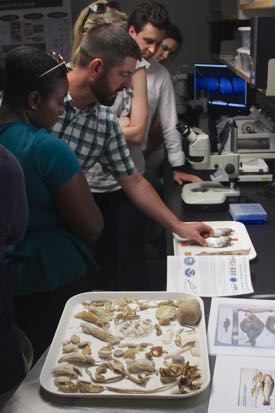
Smolinsky says the staffers remarked on the diversity of work taking place at VIMS, and the appreciation they gained concerning the challenges the Commonwealth faces from sea-level rise and climate change.
He adds that the staffers were steadfast in their appreciation for the role of science in policymaking. Said one staffer, “the ability to rely on VIMS and those at the Institute for background helps policymakers more effectively do their jobs.”
Laura Lyon, a legislative aide in the office of Congressman Scott Taylor, says "it was great being able to see all the different areas of research VIMS offers and to hear how it applies and is relevant to everyday people and businesses. Their work directly and indirectly supports jobs and the economy by providing key research that allows certain industries to flourish and maintain longevity."



